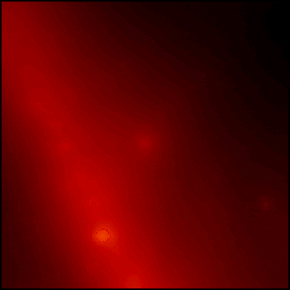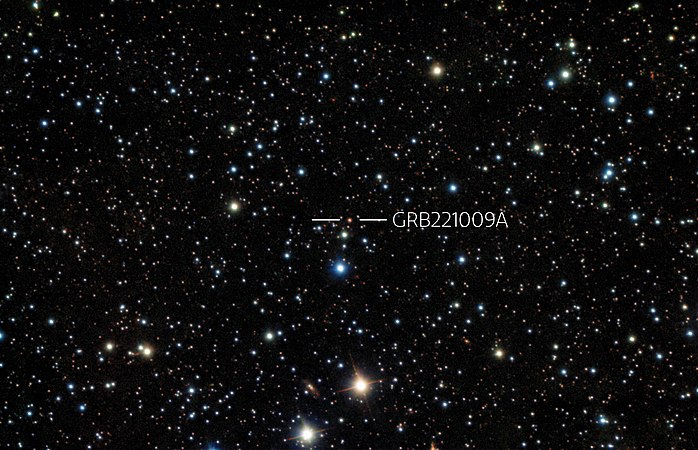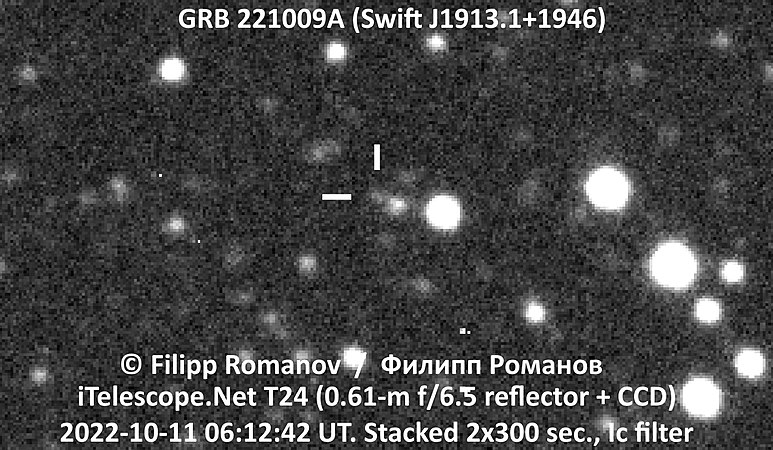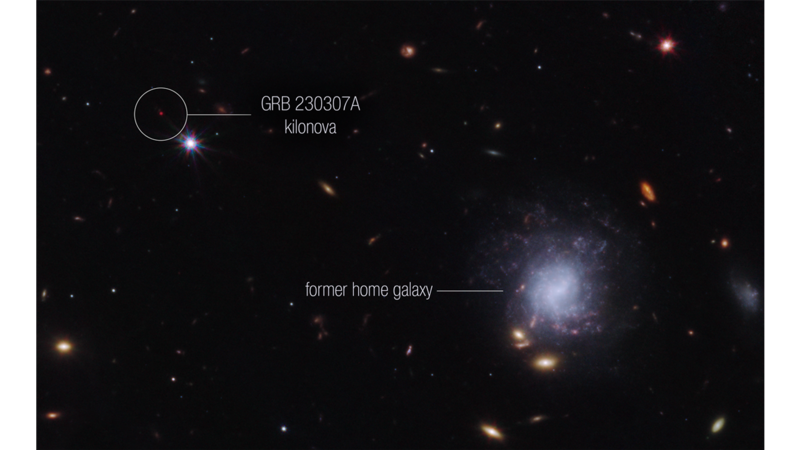Gamma-ray burst
GRB 221009A also known as Swift J1913.1+1946 was an unusually bright and long-lasting gamma-ray burst (GRB) jointly discovered by the Neil Gehrels Swift Observatory and the Fermi Gamma-ray Space Telescope on October 9, 2022. The gamma-ray burst was around seven minutes long,[1] but was detectable for more than ten hours following initial detection,[2][3] and for several hours was bright enough in visible frequencies to be observable by amateur astronomers.[4] Despite being over 2 billion light-years away, it was powerful enough to affect Earth's atmosphere, having the strongest effect ever recorded by a gamma-ray burst on the planet.[5][6][7][8][9] The peak luminosity of GRB 221009A was measured by Konus-Wind to be ~ 2.1 × 1047 J/s and by Fermi-GBM to be ~ 1.0 × 1047 J/s over the 1.024s interval.[10] A burst as energetic and as close to Earth as 221009A is thought to be a once-in-10,000-year event.[11][10] It was the brightest and most energetic gamma-ray burst ever recorded, being deemed the "BOAT", or brightest of all time.[10][12][13]
Characterization
GRB 221009A came from the constellation of Sagitta and occurred an estimated 1.9 billion years ago,[14] however its source is now 2.4 billion light-years away from Earth due to the expansion of the universe during the time-of-flight to Earth.[15] The burst's high-intensity emissions spanned 15 orders of magnitude on the electromagnetic spectrum, from radio emissions to gamma rays. Radio signals broadcast by the winding down of whatever process created the initial burst will likely linger for years to come.[16] This broadband emission offers the rare opportunity to study normally-fleeting GRBs in great detail.[14][16]
Observation
The burst saturated the Fermi Gamma-ray Space Telescope's detector,[17] which captured gamma ray photons with energies exceeding 100 GeV.[18] GRB 221009A is by far the most productive event for very high energy (VHE) photons ever witnessed by scientific instrumentation. Before GRB 221009A, the number of very high-energy photons detected over the entire history of GRB astronomy numbered only a few hundred. When the burst's radiation arrived at Earth the Large High Altitude Air Shower Observatory (LHAASO) alone saw more than 5,000 such VHE photons. Some of these photons arrived at Earth carrying a record 18 TeV of energy,[19][4] more than can be produced at the Large Hadron Collider (LHC) at the European Center for Nuclear Research (CERN).[20][13] Russia's Carpet-2 facility at the Baksan Neutrino Observatory may have also recorded a single 251-TeV photon from this burst.[17] These detected energies are far more than GRB 190114C, which had up to 1 TeV of energy,[21] and GRB 190829A, which had up to 3.3 TeV of energy,[22] being the first and only GRB so far to have photons above 10 TeV.[23][24] The burst possibly had the signature of accelerating ultra-high-energy cosmic rays for the first time.[25][26][27]
GRB 221009A was subsequently observed by the Neutron Star Interior Composition Explorer (NICER),[14] The Monitor of All-sky X-ray Image (MAXI), the Imaging X-ray Polarimetry Explorer (IXPE),[28][29][9] The International Gamma-ray Astrophysics Laboratory (INTEGRAL), the XMM-Newton space telescope,[30] The Large High Altitude Air Shower Observatory (LHASSO)[31][32] and many others.[20][33]
Possible causes
GRB 221009A may have been caused by a massive star undergoing a supernova,[4] or by the birth of a black hole.[18] Supernovae often lead to the formation of a black hole if the parent star is too massive for stable neutron star formation, and it is not yet known which part of, or whether, the death of a star was responsible for this gamma-ray burst. Some physicists speculate that the exceptionally high-energy photons observed during 221009A could be the result of previously theoretical or unknown physical processes involving dark matter,[17] axions, or decaying sterile neutrinos.[34] As yet there is no conclusive evidence that this gamma-ray burst was caused by a supernova;[35][36][37][38] nor have any of the enormous number of neutrinos emitted by supernovae been detected.[39] Lightning detectors in India and Germany picked up signs that the Earth's ionosphere was perturbed for several hours by the burst, though only mildly,[40][17][5] as well as an enormous influx of electrically charged particles,[41] showing just how powerful it was.[42][13] It also disrupted longwave radio communications.[43] It had the strongest effect ever recorded by a gamma-ray burst on the planet.[5] Further, the relativistic jet of this gamma-ray burst has an unusual structure.[44][45]
Record magnitude
Some astronomers referred to the burst as the "brightest of all time", or by the acronym "BOAT".[17][46] This claim is easily justified by the record of known gamma-ray bursts.[10] Dan Perley, an astrophysicist at the Astrophysics Research Institute at Liverpool John Moores University, stated "There is nothing in human experience that comes anywhere remotely close to such an outpouring of energy. Nothing."[47] Eric Burns, an astronomer at Louisiana State University, also stated about the energy of the burst that "The energy of this thing is so extreme that if you took the entire Sun and you converted all of it into pure energy, it still wouldn't match this event. There's just nothing comparable."[48] The power of gamma-ray bursts may be gauged by the degree of interaction between the gamma rays they emit and the ubiquitous lanes of interstellar dust in deep space. Such interactions generate an afterglow in X-ray frequencies, usually seen as concentric rings of scattered X-rays with the gamma ray burst at the center. GRB 221009A is only the seventh gamma-ray burst known to have generated these rings.[11] The X-ray afterglow of 221009A was around a thousand times brighter than the typical GRB,[42] and as of June 2023 a record twenty X-ray afterglow rings had been identified around the burst.[49][11] The burst had the brightest X-ray afterglow ever recorded,[44] and the brightest UVOT afterglow ever recorded once corrected for extinction.[50] It had the largest amount of energy ever recorded in the TeV range,[51] and had the most energetic photons ever recorded for a GRB, peaking at 18 TeV.[23][19] The burst was ten times brighter than any previous GRB detected by the Swift mission.[52] It was the brightest and most intense GRB detected by KONUS-Wind.[53] The prompt emission of the burst far surpassed anything before it, far exceeding four previous GRB record-holders, as no GRB had been recorded delivering more than 500,000 gamma-ray photons-per-second, yet this GRB peaked at over 6 million photons-per-second.[54][55] The burst was so bright that it blinded most gamma-ray instruments in space, preventing a true recording of its intensity.[11][56] It was even detected by satellites not designed to detect gamma-ray bursts, such as Voyager 1.[9] GRB 221009A could have produced multi-TeV gamma rays for more than a week after the prompt phase, with this feature being unique to GRB 221009A.[57]
With a radiated energy of around 1.2×1055 erg[10] or even 1.5×1055 erg,[58] 221009A is, together with the 1061 erg MS 0735.6+7421 event and the 5×1061 erg Ophiuchus Supercluster eruption, as among the most energetic events, however, the eruptions were high-energy low-power events occurring over millions of years as compared to GRB 221009A, which occurred over a miniscule time frame in comparison.[59] Don Lincoln described it as being the "greatest cosmic explosion humanity has ever seen".[13]
Relevance to new physics
Through comparison of data collected by different observatories, scientists concluded that the 221009A event was 50 to 70 times brighter than the previous record holder, along with it being far more energetic than the previous record holder.[33][11][45][12] The extremely bright peak and long afterglow may help physicists study the manner in which matter interacts at relativistic speeds, the only known regime capable of generating gamma ray photons with more than 100 GeV of energy.[14] Study of 221009A and similarly extreme events are at present humanity's only access to particles with energies larger than any that can be generated artificially. The close examination of 221009A may eventually yield physical explanations that are neither predicted by nor accounted for in the Standard Model.[17] It has become the most studied gamma-ray burst in history.[60]



![Swift's X-ray image of GRB 221009A shows circular rings around the gamma-ray burst. Dust in the Milky Way scattered the x-ray emission of the gamma-ray burst, creating the rings.[29]](https://upload.wikimedia.org/wikipedia/commons/thumb/5/5f/Xrt_image_crop.jpg/452px-Xrt_image_crop.jpg)



